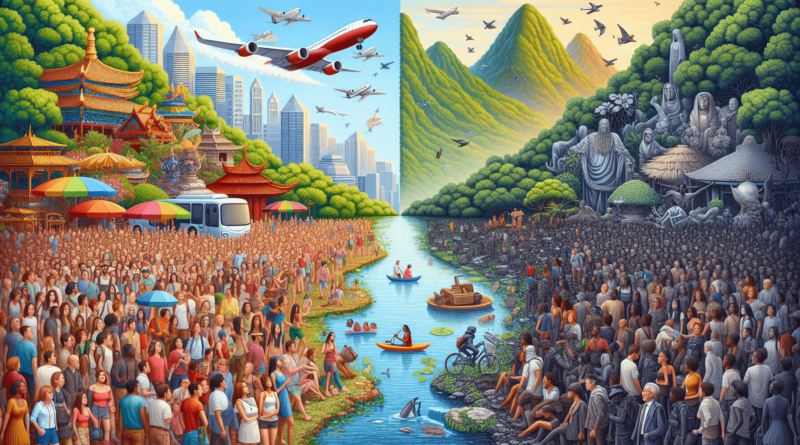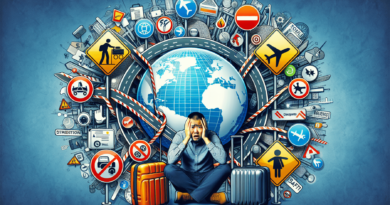Possible Solutions for UPRISING Issues in Travel
You’ve probably noticed a few UPRISING issues that have been plaguing the travel industry lately. From increasing costs to lack of transparency and heightened security concerns, it’s clear that we need some innovative solutions. In this article, we’ll explore potential fixes for these problems, aimed at making your travel experience smoother and more enjoyable. Whether you’re a frequent flyer or an occasional vacationer, you’re bound to find some valuable insights.
Overcrowding at Tourist Destinations
One of the significant issues that most travel destinations face is overcrowding. This results from various factors, one of which is the specialization and growth of the tourism industry, which increasingly draws people to renowned destinations. Another cause is an improved standard of living and subsequent increase in disposable income, enabling more people to travel frequently. Few places are now tough to reach, and this accessibility has led to overcrowding.
Understanding the cause of overcrowding
The reasons behind overcrowding at tourist destinations are multi-faceted. One main culprit is the rise of budget airlines and affordable accommodation sites like Airbnb that have made travel more accessible to more people. Additionally, globalization, improved infrastructure, and ease of travel visa procedures feed into the growth of tourism, leading to overcrowding.
Implications of overcrowding
Overcrowding at tourist destinations leads to multiple consequences, ranging from environmental degradation to a decrease in local quality of life due to increased cost of living. Also, the pressure to accommodate a large influx of visitors may lead to the erosion of cultural authenticity and diversity in those places.
Proposing policies for crowd management
Effective crowd management policies are paramount to tackle overcrowding at tourist hotspots. Policies may include the imposition of a visitation limit, promotion of tourism in off-peak seasons, and the development of lesser-known tourist sites to divert tourists from the main crowded areas. This way, the environment, and quality of life for residents are preserved, and tourists get a more rewarding experience.
Climate Change and Environmental Impact
Climate change is a global concern and a significant challenge the tourism industry needs to confront. Considering the vast international structures and mobility involved, the industry has a significant role in global carbon emissions through air travel and cruise ship traffic.
Insight into how tourism contributes to climate change
Tourism contributes to climate change mainly through transportation, accommodation, waste disposal, and food. Airplane emissions each comprise about two percent of all global carbon emissions. Besides, the excessive disposal of tourists’ waste also contributes to environmental pollution and, consequently, climate change.
Comprehending the environmental impact of tourism
Tourism’s environmental impact stretches beyond global warming. Over-tourism results in littering, disturbance of wild life, traffic congestion, and strain on water resources. It also causes issues like soil erosion, increased pollution, natural habitat loss, and strain on endangered species. These experiences often result in a vicious cycle of exploiting the environments that attract tourists.
Sustainable travel solutions to reduce environmental damage
Fortunately, sustainable travel solutions are gaining traction. These include promoting eco-tourism, implementing environmentally friendly practices in hotels and resorts, encouraging tourists to use public transportation, and educating tourists about the principles of leave no trace. By traveling locally or choosing destinations committed to sustainability, tourists can greatly reduce their environmental footprint.
Economic Inequality and Tourism
While tourism can boost local economies and contribute to development, it also has the potential to exacerbate economic inequality.
Assessing the economic disparity created by tourism
Large resorts and foreign-owned businesses often swallow up the vast majority of tourism revenue, leaving the local people with little income. This unequal distribution of benefits is especially prominent in developing countries where a minimal portion of tourism revenue trickles down to the lower income groups.
The imbalance in wealth distribution in tourist spots
Wealth disparity also manifests in inflated property and living costs in tourist-frequented areas. This increase in living cost and property prices may result in locals being edged out of their homes and communities. In many cases, the tourism industry leads to gentrification, significantly altering the socioeconomic fabric of local neighborhoods.
Potential solutions for promoting fair economic gain
Potential solutions to this problem involve policy changes that ensure local communities reap more benefits from tourism. This could be through prioritizing local businesses in the supply chain or adopting minimum wage policies. Tourism can also be channeled into supporting local development projects, thereby using the industry as a force for good.
Customer Service and Satisfaction Issues
Quality customer service is essential in the travel industry, significantly influencing tourist satisfaction and repeated visits. However, many travelers frequently encounter issues with customer service, which could negatively impact their overall experience.
Identifying common complaints by travelers
Common complaints by travelers often revolve around communication challenges, unfriendly staff, inadequate information, or unreliability of services. Network issues or poor Wi-Fi services also contribute to an unsatisfactory customer experience.
The impact of poor customer service on the travel industry
Poor customer service in the travel industry could be of profound impact. Dissatisfied patrons are less likely to return, potentially tarnish a brand’s reputation through negative reviews and feedback, and compromise the growth and profitability of businesses.
Providing high-quality customer service
To provide high-quality customer service, staff should be trained to effectively handle queries and complaints, and companies might have more multilingual representatives. Additionally, they should prioritize efficiency, reliability, and communication. Travel businesses can also leverage technology to streamline service and improve customer satisfaction by deploying bots for quicker response times or apps to ease service delivery.
Health and Safety Concerns
Traveling involves stepping out from one’s comfort zone, which occasionally entails risks. Travelers are exposed to health hazards and security threats that could potentially spoil their travel experience.
Health hazards during travel
The health hazards one might face while traveling range from food poisoning and diarrhea to novel diseases unique to specific countries or continents. In addition, travelers might also get exposed to air pollution in cities or risk altitude and mountain sickness.
Safety threats while traveling
Safety threats, on the other hand, run the gamut from petty thefts to terror attacks. These insecurities usually stem from differences in cultural norms, lack of awareness, or unpredictable events beyond the travelers’ control. Travelling in an unknown environment exposes travelers to particular risks, intensified by language barriers and unfamiliarity with the locale.
Policies and guidelines for improving health and safety
Implementing guidelines for improving health and safety is paramount to ensuring a smooth journey for travelers. It could include regular diet and hygiene standards checks, routine hotel safety inspections, or the provision of timely information on pandemic outbreaks. Travel advisories and adequate travel insurance are also essential tools for keeping travelers safe abroad.
Increasing Costs of Travel
The rising costs of travel pose a significant challenge for both the industry and tourists. Increased costs deter potential travelers and may take a toll on the industry.
Exploring the reasons behind rising travel costs
The increment in travel costs could be attributed to factors such as inflation, higher fuel prices, currency fluctuations, and increased overheads for travel service providers. Government taxation and legislation can also escalate the overall cost of travel packages.
The effect of increased costs on tourism
The increased cost of travel can have a significant impact on tourism, discouraging potential tourists, especially budget travelers. Increases in cost can also draw criticism and negative reviews, potentially harming destinations ‘ reputation and attractiveness.
Approaches to make travel more affordable
Making travel more affordable needs concerted efforts. Key approaches could involve intense competition in the travel and airline industry, package deals, and embracing alternative lodging options. Authorities can also partner with airlines, hotels, and tour operators to offer discounted rates during off-peak periods.
Technological Challenges
Technology has revolutionized travel, from online bookings to digital concierge services. However, it’s not devoid of challenges.
Understanding the role of technology in travel
Technology plays an imperative role in modern travel experience. It provides apps for flight check-in, GPS for navigation, online reviews to select the best restaurants and accommodations, and social media for sharing travel experiences. Despite these products aimed at making travel more seamless, the landscape is riddled with headaches related to connectivity, compatibility, andtechnical issues.
Common technological issues faced by travelers
Common technological issues faced by travelers include unreliable internet connectivity, high roaming charges, difficulty in charging devices due to incompatible plugs or voltage, and data security concerns. Moreover, the high reliance on digital tools can lead to a setback when these tools fail.
Solutions for incorporating seamless technology into travel
To incorporate technology seamlessly into travel, responsible parties should ensure stable internet connection in accommodation and tourist areas. Work on universal charging solutions should be encouraged to resolve charging issues. Most importantly, strengthening the security of digital platforms is necessary to protect travelers’ data.
Issues with Infrastructure
Infrastructure is the backbone of tourism, making tourist destinations accessible and comfortable.
Problems with transportation and accommodation
The lack of convenient transport options, poorly managed public transportation systems, and inadequate accommodations are notable challenges tourists may encounter. These issues can limit accessibility and affect a tourist’s overall experience.
Infrastructure failure affecting tourism
Poor infrastructure not only deters tourists from visiting but can also impact the local economy that largely depends on tourism. It can lead to traffic congestion, overcrowding, and strain on resources, eventually impacting the destination image and level of visitor satisfaction.
Need for infrastructural development in popular tourist spots
For sustainable tourism, infrastructural development is vital. This entails enhancing public transportation, expanding accommodation options to meet demand, improving roads, and providing necessary amenities. Ongoing maintenance is equally important to ensure tourist hotspots can withstand the pressure of increased tourist inflow.
Cultural Misunderstandings and Conflicts
Tourism often brings together people from differing cultural backgrounds. During this interaction, there is a high chance of misinterpretation and misunderstanding.
Identify cultural miscommunications affecting tourism
Cultural miscommunication can stem from language barriers, different non-verbal communication norms, and unfamiliarity with local customs and traditions. Often, these misunderstandings can lead to embarrassing situations, conflicts or even legal troubles.
Role of cultural awareness in enhancing travel experience
Cultural awareness plays a vital role in enhancing the travel experience. It fosters respect for the host cultures, reduces chances of cultural miscommunication, and enriches the travel experience by encouraging a deeper understanding of the locale.
Cultural sensitivity training for staff in the travel industry
Cultural sensitivity training for staff in the tourism sector can significantly minimize misunderstandings. Training enables staff to handle a diverse range of clients, cater to their varied needs, and avoid potential cultural faux pas. It also teaches professionals how to provide culturally relevant information to travelers to foster understanding and appreciation.
Political Instability and Travel
Political stability is a key consideration for tourists planning their trips.
Effect of political unrest on tourism
Political unrest such as civil wars, protests, and terrorist attacks can negatively impact tourism as they jeopardize tourists’ safety. Such volatile situations tend to deter tourists from choosing such regions as their travel destination, leading to a considerable slump in the tourism economy.
Travel advisories during political turmoil
In times of political turmoil, travel advisories play a critical role in keeping travelers informed of the risks involved. They provide up-to-date and reliable information on the security situation of a region, helping tourists make informed decisions on their travel plans.
Devising strategies for travel during political instability
Devising strategies for travel during political instability involves travel insurance, staying updated on political news of the destination, understanding the implications of your home country’s relationship with the travel destination, and having access to emergency contact details. It’s crucial to have a well-prepared plan and stay cautious to ensure personal safety and security when traveling amidst such uncertainty.




